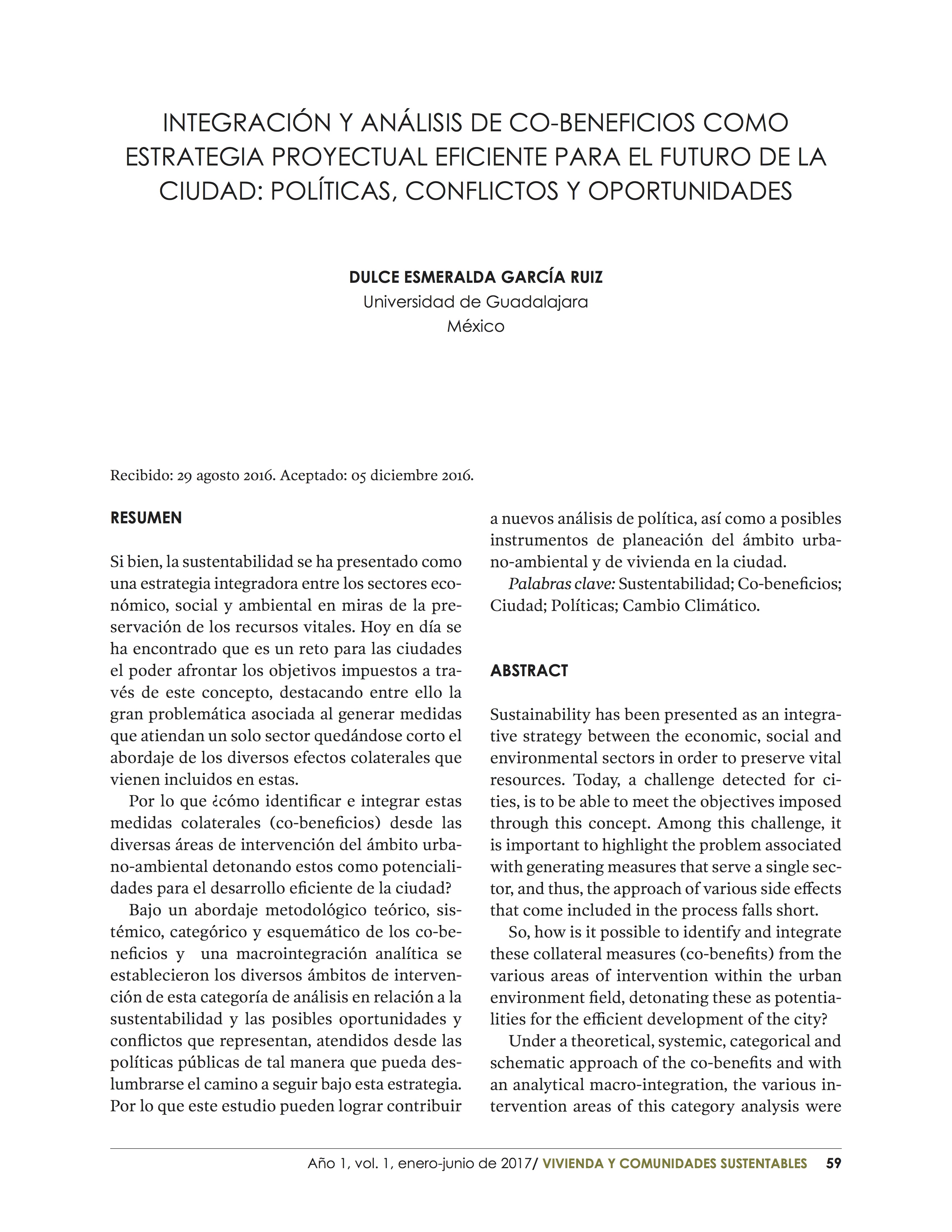Integración y análisis de co-beneficios como estrategia proyectual eficiente para el futuro de la ciudad: políticas, conflictos y oportunidades
DOI:
https://doi.org/10.32870/rvcs.v0i1.5Palabras clave:
Sustentabilidad, co-beneficios, ciudad, políticas, cambio climáticoResumen
Si bien, la sustentabilidad se ha presentado como una estrategia integradora entre los sectores económico, social y ambiental en miras de la preservación de los recursos vitales. Hoy en día se ha encontrado que es un reto para las ciudades el poder afrontar los objetivos impuestos a través de este concepto, destacando entre ello la gran problemática asociada al generar medidas que atiendan un solo sector quedándose corto el abordaje de los diversos efectos colaterales que vienen incluidos en estas. Por lo que ¿cómo identificar e integrar estas medidas colaterales (co-beneficios) desde las diversas áreas de intervención del ámbito urbano-ambiental detonando estos como potencialidades para el desarrollo eficiente de la ciudad? Bajo un abordaje metodológico teórico, sistémico, categórico y esquemático de los co-beneficios y una macrointegración analítica se establecieron los diversos ámbitos de intervención de esta categoría de análisis en relación a la sustentabilidad y las posibles oportunidades y conflictos que representan, atendidos desde las políticas públicas de tal manera que pueda deslumbrarse el camino a seguir bajo esta estrategia. Por lo que este estudio pueden lograr contribuir a nuevos análisis de política, así como a posibles instrumentos de planeación del ámbito urbano-ambiental y de vivienda en la ciudad.Métricas
Citas
Castillo, C. K., D. Cromwell Sanqui, M. Ajero, y C. Huizenga, (2007). The Co-Benefits of Responding to Climate Change: STATUS in ASIA. Manda luyong, Philippines, Asia: US EPA; MO; CAI Asia.
Economist Intelligence Unit, 2010. Índice de las ciudades verdes en América Latina. Munich: Siemens AG.
García, D. E. (2015). Co-beneficios en la vivienda sus tentable metropolitana. Guadalajara: II Congreso investigadoras del SNI.
López,V.L.(2014).Sustentabilidadydesarrollosus tentable: origen, precisiones conceptuales y metodología operativa . México: Trillas.
Balaban, O. (2013). Co-Benefits of Green Buildings and the Opportunities and Barriers Regarding their Promotion. UNU IAS; TUBITAK.
Bollen, et al. (2009) Co-benefits of climate change mitigation policies: literature review and new results. París: Organization for Economic Cooperation and Development.
Foladori, G y N. Pierri (2005). Sustentabilidad Desacuerdo sobre el desarrollo sustentable. México: Universidad Aut noma de Zacatecas/Porra.
Garza Gutiérrez, E. y E. González Gaudino (2010).
De las teorías del desarrollo al desarrollo sustentable. México: UANL/ Siglo XXI.
IPCC. (2007). Climate Change 2007: Working Group
III: Mitigation of Climate Change. Recuperado el 22 de enero de 2017, de IPCC Fourth Assessment Report: Climate Change 2007: https://www.ipcc.ch/publications_and_data/ar4/wg3/en/ch7s7 10 .html
IPCC, 2007: Climate Change 2007: Impacts, Adaptation and Vulnerability. Contribution of
Working Group II to the Fourth Assessment Report of the Intergovernmental Panel on Climate Change, M.L. Parry, O.F. Canziani, J.P. Paluti Kof, P.J. van der Linden and
C.E. Hanson (Eds.), Cambridge University Press, Cambridge, UK, 976pp.
Miyatsuka, A. y E. Zusman (s.f.). Fact Sheet No.1 What are Co-benefits? (ACP, Ed.) Recuperado el 22 de enero de 2017, de https://pub.iges.or. jp/system/les/publication_documents/pub/ nonpeer/2393/acp_factsheet_1_what_cobenefit s.pdf
Nascimento, Moreira, Hardt y Schussel, 2015. Analise de políticas públicas entre modelagem e a realidade da política habitacional brasileira . R o de Janeiro: Rev. Adm. Pública.
Olgyay, V. (2013). Arquitectura y clima Manual de diseño bioclimatico para arquitectos y urbanistas. Estados Unidos: Gustavo Gili.
Smith, A. (2013). The climate bonus. Co-benefit of Climate Policy. (Kindle, Ed.) Abingdon: Rout ledge y Earthscan. https://doi.org/10.4324/9780203109571
Stern, N. (2006). Stern review on the economics of climate change. Reino Unido: Government of the United Kingdom. https://doi.org/10.1017/CBO9780511817434

Descargas
Publicado
Cómo citar
Número
Sección
Licencia
Derechos de autor 2017 Vivienda y Comunidades Sustentables

Esta obra está bajo una licencia internacional Creative Commons Atribución-NoComercial-SinDerivadas 4.0.
Los autores/as que publiquen en esta revista aceptan las siguientes condiciones:
De acuerdo con la legislación de derechos de autor, Vivienda y Comunidades Sustentables reconoce y respeta el derecho moral de los autores, así como la titularidad del derecho patrimonial, el cual será cedido a la Universidad de Guadalajara para su difusión en acceso abierto. Vivienda y Comunidades Sustentables no realiza cargos a los autores por enviar y procesar artículos para su publicación.
Los autores/as pueden realizar otros acuerdos contractuales independientes y adicionales para la distribución no exclusiva de la versión del artículo publicado en Vivienda y Comunidades Sustentables (por ejemplo incluirlo en un repositorio institucional o publicarlo en un libro) siempre que indiquen claramente que el trabajo se publicó por primera vez en Vivienda y Comunidades Sustentables.





